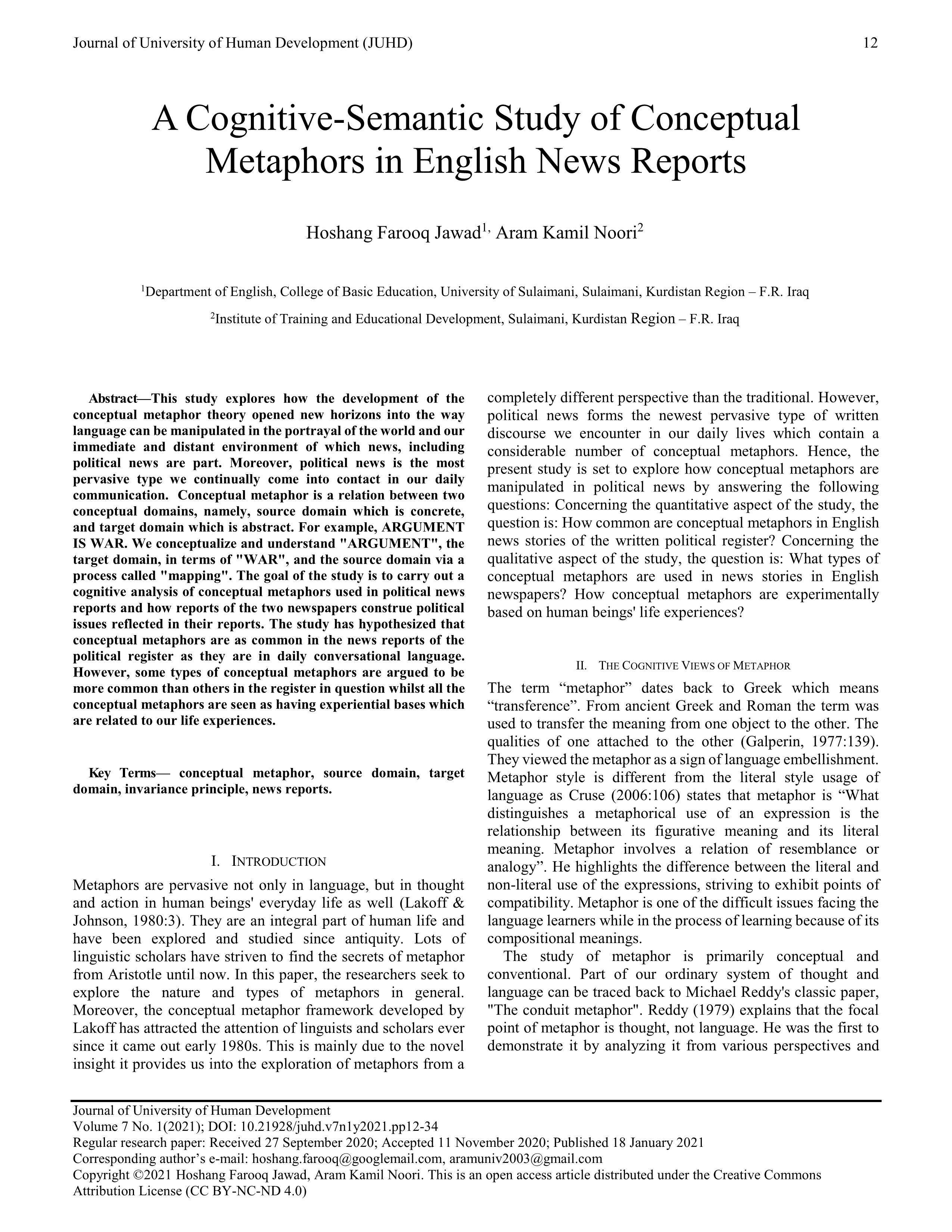A Cognitive-Semantic Study of Conceptual Metaphors in English News Reports
DOI:
https://doi.org/10.21928/juhd.v7n1y2021.pp12-34Keywords:
conceptual metaphor, source domain, target domain, invariance principle, news reportsAbstract
This study explores how the development of the conceptual metaphor theory opened new horizons into the way language can be manipulated in the portrayal of the world and our immediate and distant environment of which news, including political news are part. Moreover, political news is the most pervasive type we continually come into contact in our daily communication. Conceptual metaphor is a relation between two conceptual domains, namely, source domain which is concrete, and target domain which is abstract. For example, ARGUMENT IS WAR. We conceptualize and understand "ARGUMENT", the target domain, in terms of "WAR", and the source domain via a process called "mapping". The goal of the study is to carry out a cognitive analysis of conceptual metaphors used in political news reports and how reports of the two newspapers construe political issues reflected in their reports. Accordingly, the study aims to provide answers to such questions as: How common are conceptual metaphors in English news reports of the online political register? What types of conceptual metaphors are used in news reports in English newspapers? How conceptual metaphors are experimentally based to human beings' life experiences? Based upon these research questions, it is hypothesized that Conceptual metaphors are argued to be as common in the news reports of the political register as they are in daily conversational language. Some types of conceptual metaphors are argued to be more common than others in the register in question. Moreover, all the conceptual metaphors are argued to have experiential bases which are related to our life experiences.
Index Terms— conceptual metaphor, source domain, target domain, invariance principle, news reports.
References
Conboy, M. (2007). The Language of News. London: Routledge.
Cruse, A. (2006). A Glossary of Semantics and Pragmatics. Edinburgh: Edinburgh University Press.
Day, D., Jordan, P. and Wingate, J. (2017). Substance Metaphor. [online] SIL Glossary of Linguistic Terms. Available at: http://www.glossary.sil.org/term/substance-metaphor [Accessed 14 Jul. 2014].
Evans, V. and Green, M. (2006). Cognitive linguistics. Edinburgh: Edinburgh University.
Galperin, I. (1977). Stylistics. Moscow: Higher School.
Kövecses, Z. (2008). Conceptual metaphor theory: Some criticisms and alternative proposals. [online] Academia.edu. Available at: http://www.academia.edu/5452404/Conceptual_metaphor_theory_Some_criticisms_and_alternative_proposals [Accessed 18 Oct. 2014].
Kövecses, Z. (2010). Metaphor: A Practical Introduction. 2nd ed. Oxford University Press: Oxford University Press.
Lakoff, G. and Johnson, M. (1980). Metaphors we live by. Chicago: Univ. of Chicago Press.
Lakoff, G. and Johnson, M. (1980). The Metaphorical Structure of the Human Conceptual System. Cognitive Science, [online] 4(2), pp.195-208. Available at: http://onlinelibrary.wiley.com/doi/10.1207/s15516709cog0402_4/pdf [Accessed 1 Nov. 2014].
Lakoff, G. (1987). Women, fire, and dangerous things. Chicago (Ill.): University of Chicago Press.
Lakoff, G. (1993). The Conduit Metaphor: A Case of Frame Conflict in Our Language about Language. In: A. Ortony, ed., Metaphor and Thought. Cambridge: Cambridge Univ. Press.
Lakoff, G. (1993). The Contemporary Theory of Metaphor. In: A. Ortony, ed., Metaphor and Thought. Cambridge: Cambridge Univ. Press.
Lakoff, G. (2009). The political mind. New York: Penguin Books.
LAKOFF, G. (1990). The Invariance Hypothesis: is abstract reason based on image-schemas?. Cognitive Linguistics, [online] 1(1), pp.39-74. Available at: https://georgelakoff.files.wordpress.com/2014/11/invariance-hypothesis-lakoff-1990.pdf [Accessed 1 Apr. 2015].
Liu, X. and Zhao, G. (2013). A Comparative Study of Emotion Metaphors between English and Chinese. Theory and Practice in Language Studies, [online] 3(1). Available at: https://pdfs.semanticscholar.org/4a28/31dbe86eb40731845602c56d2daf3b0ebcfe.pdf [Accessed 13 Nov. 2013].
Richards, I. (1936). The philosophy of rhetoric. Oxford: Oxford University Press.
Ruiz de Mendoza Ibáñez, F., de Mendoza Ibáñez, F. and Hernández, L. (2011). The Contemporary Theory of Metaphor: Myths, Developments and Challenges. [online] Academia.edu. Available at: http://www.academia.edu/2061405/The_Contemporary_Theory_of_Meta phor_Myths_Developments_and_Challenges [Accessed 10 Mar. 2015].
Saeed, J. (2009). Semantics. New York, NY: John Wiley & Sons.
Tendahl, M. (2009). A hybrid theory of metaphor. Basingstoke: Palgrave Macmillan.
Websites consulted:
www.theguardian.com/uk
www.washingtonpost.com/



